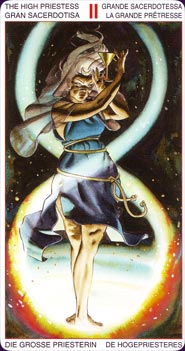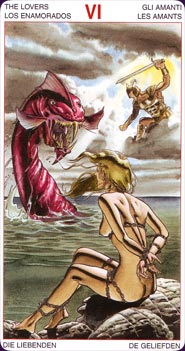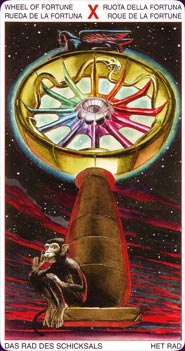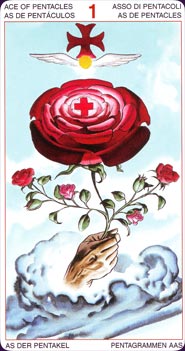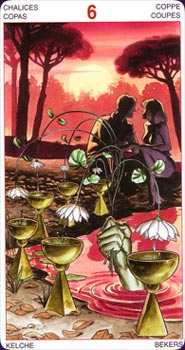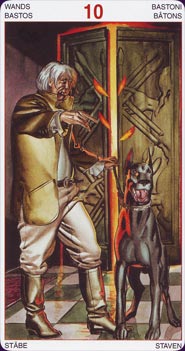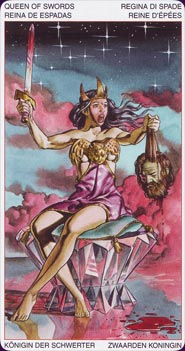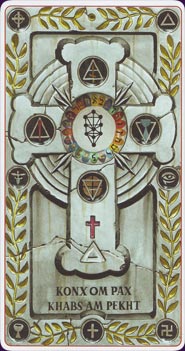Initiatory Tarot of the Golden Dawn Deck Review
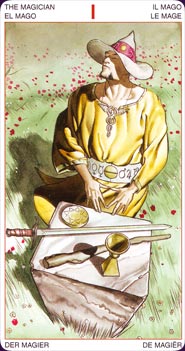
Creators: Giordano Berti, Patrizio Evangelisti
Published: 2008
The Initiatory Tarot of the Golden Dawn has been created from documents from the occult group. The deck artist was without any knowledge of their previous decks, so the result is comic-book style illustrations with familiar elements in new interpretations.
Retailers
See Price at Amazon.comSee Price at Amazon.co.uk
Initiatory Tarot of the Golden Dawn Review by Lillie
The Initiatory Tarot of the Golden Dawn by Lo Scarabeo is a 78 card tarot deck based upon the semi mythical Golden Dawn deck designed in the late 19th century by S L Mathers for the use of initiates of the order. We are told in the accompanying booklet that the Lo Scarabeo deck takes its designs from the extant writings of the Golden Dawn on the tarot, Liber T and the essay on the tarot trumps by G H Soror Q L, and is intended to take the esoteric symbolism enshrined in the Golden Dawn teaching and make them accessible to the modern tarot reader.
The accessibility of this deck as a divination device cannot be questioned; the images by artist Patrizio Evangelisti are beautifully executed, attractive and engaging. The dramatic poses and angles, the evocative characters and landscapes make this deck a pleasure to read with. The thematic and elemental structure of the illustrated minors and courts make them easy to differentiate and familiar to anyone used to the RWS or its clones. The majors, whilst containing some unusual images drawn from Golden Dawn teachings such as The Fool or The Lovers, will nevertheless be familiar enough to cause no trouble to the average reader whether they use book meanings or intuitive methods of reading.
However, as its title would suggest these cards claim to be more than just a beautiful divination deck, rather it is intended to reproduce the occult meaning and symbolism of the original Golden Dawn deck. Therefore this deck must be judged against its stated objective and its quoted sources. To do that one must first consider how the Golden Dawn perceived the tarot.
For the Golden Dawn the tarot was more than a divination tool, it was a pictorial representation of the cabalistic tree of life, of the powers and forces of the spheres, paths and worlds which are themselves a map of the universe. The whole of the Golden Dawn’s philosophy and teaching was symbolically contained in the images of the tarot; and the magickal journey through the grades of the order was mapped by the tarot cards that represented the paths of the tree that the novice would ascend during his magickal training. For the golden Dawn therefore ever line, every colour every object was filled with meaning and would have spoken to the user through the elaborate system of correspondences employed by the order.
Sadly the original deck devised by Mathers is long lost and all that remains are a handful of writings and descriptions left to us by members. The two most important of these are the document known a Liber T, written by Mathers which describes in detail the court cards and the minors but gives only the orders beautiful and evocative names for the majors and the astrological and Hebrew letter correspondences. An unofficial document written by G H Soror Q L gives brief descriptions of the majors but pays more attention to the colour scales and the mystic significance of the cards rather than to their imagery. Nevertheless it is these two sources that are quoted in the booklet as supplying the genesis of the images on The Initiatory Tarot of the Golden Dawn. Even a cursory glance at this deck is enough to show that it does not comply entirely with these two sources. It is clear that unlike the Wang deck that attempted to recreate the deck as the members of the Golden Dawn would have seen it, this is instead a reinterpretation of the writings of Mathers and Soror Q L.
The majors follow the well known Golden Dawn pattern that places Strength at VIII and Justice at XI; the Fool, numbered zero is imaged as a child and a wolf, the Lovers as Perseus freeing Andromeda from the rock. Although very little is shown that directly contradicts the essay on the trumps by Soror Q L, the ostensible source for these images, it is clear that another source must have been used for some of the symbolism contained in these cards. The booklet states categorically that the artist did not consult other recreations of the Golden Dawn deck yet there are numerous points of congruence between this deck and the Wang deck; symbols that do not commonly appear on tarot cards and are not mentioned in the essay by Soror Q L but appear on both this deck and the Wang deck. Examples of this would include the cup in the hand of the Priestess, the scroll held by the Hierophant and the eagle and the snake on the death card. These indicate that a further source was used in the creation of these images, one that is not mentioned in the accompanying booklet. It would have been helpful if it had been named as the descriptions by Soror Q L are often brief and unhelpful and make it difficult to judge how well this deck does or does not comply with the esoteric symbolism of the Golden Dawn.
The images on the court cards appear to be drawn entirely from the detailed descriptions in Liber T, beautifully drawn and full of life and character. There is some small loss of symbolism on some cards, particularly the loss of the crab on the Knight of Chalices and the reversal of the positions of the orb and sceptre on the Prince of Discs; but these are small matters compared to the way the artist has captured the spirit of each card. The court are titled after the Crowley pattern; Knight, Queen, Prince and Princess rather than the more proper but also more confusing Golden Dawn titles Knight, Queen, King and Princess. The booklet makes some attempt to explain the sense of the court cards, but in such a brief work it is impossible for the writer to go into much detail or to address the issues such as the 16 sub elements as defined in the Golden Dawn court.
The minors are where this deck deviates most from known Golden Dawn imagery. As with the court cards Liber T describes the minors in detail and in this description they are entirely symbolic. The progression of the elements as they descend the tree of life are represented only by flames that burst from the wands, the lotus flowers that fill the chalices with water, the five petaled rose that is torn by the swords of air and by the buds on the rose bush that bears the pentacles of earth. The Initiatory Tarot of the Golden Dawn chooses to illustrate the minors pictorially, sometimes making the Golden Dawn symbols part of the design, other times relying more upon RWS iconography. It may seem that this is contrary to the Golden Dawn writings; it is certainly far different from the deck the initiates of the order would have seen, yet these pictorial cards do illustrate an aspect of the Golden Dawn’s teaching not usually addressed.
Aleister Crowley, possibly the most famous initiate of the Golden Dawn states in his ‘Book of Thoth’ that the cards are living beings and asks us to imagine a room filled with 78 individuals. Alongside this idea are the names the Golden Dawn gave to the 78 cards of the tarot; names both beautiful and wonderfully redolent of mystery. Under this nomenclature the minor cards are named as Lords, the power of the spheres is personalised and individualised, the Two of Chalices is names as ‘The Lord of Love’, the Ten of Pentacles is ‘The Lord of Wealth’ and so on. The artist has managed to convey the individuality of these forces in his illustrations. The eight of Wands, ‘The Lord of Swiftness’ is depicted as a running woman where every line speaks of the force she illustrates. Likewise the five of Swords, ‘The Lord of Defeat’ is armoured and helmed in black, his foot upon the neck of his defeated enemy. This personalisation of the Lords of the minor arcana may not meet with the approval of the Golden Dawn purists, but to this reviewer it is the highlight of the deck and reveals an aspect of the orders teaching never before seen in a Golden Dawn deck.
The main problem with this deck is one it shares with all Golden Dawn decks. It is not truly accessible to the general reader as anything other than an ordinary, if beautiful, divination deck. It may use golden Dawn symbolism, but as with all Golden Dawn decks it explains nothing in and of itself. For an initiate of the Golden Dawn the tarot and its symbols would have been part of a lengthy magickal education during which they would have learned cabalistic theory, magickal correspondences and the significance of the colour scales until the symbols on the cards were as automatically understood as a pictorial road sign is to the modern motorist. Without the knowledge to read them the symbols are meaningless, it is not enough to show that the Golden Dawn used Perseus and Andromeda on the Lovers card if we do not know why and whilst some knowledge can be gleaned from published sources it is no substitute for the years of study that an initiate of the Golden Dawn would have undergone. Without this knowledge all Golden Dawn decks are little more than a curiosity, a recreation of an historical artefact divorced from its original context and meaning. The Initiatory Tarot of the Golden Dawn is nevertheless the most beautiful of all Golden Dawn deck, and with it’s depiction of the minors has brought something new to the genre and has allowed at least a part of the orders ideas on the tarot to be seen in a new and original way.
Complete Details of Initiatory Tarot of the Golden Dawn
Creators: Giordano Berti, Patrizio EvangelistiPublisher: Lo Scarabeo 2008
Deck Type: Tarot Deck
Cards: 78
Major Arcana: 22
Minor Arcana: 56
Deck Tradition: Golden Dawn
Minor Arcana Style: Unique Scenes With Suit Symbols
Suits: Chalices, Swords, Wands, Pentacles
Court Cards: Princess, Prince, Queen, Knight
The Fool is 0
Strength is 8/11
Justice is 11/8
Card Size: 2.60 x 4.72 in. = 6.60cm x 12.00cm
Card Language: Spanish, Italian, German, French, English, Dutch
Card Back: Non-reversible
Back Design: Stone carved appearance with a central Golden Dawn cross and leaf design around the edges.
Companion Material: Little white booklet in five languages.
Rating: 16/20 or
Similar Decks to Initiatory Tarot of the Golden Dawn
Theme: Golden Dawn, MasculineCreator: Ludy Lescot Tarot by Patrizio Evangelisti Bacchus Tarot, Dante Tarot, Golden Tarot of the Renaissance, Pictorial Key Tarot, Tarocchi di Robot, Tarot of the Angels, Tarot of the Druids, Universal Wirth Tarot, Venice Tarot, Visconti Tarot, Visconti Tarot Mini by Giordano Berti
< Previous Deck · Back to Top · Next Deck >
Home > Tarot Reviews > Initiatory Tarot of the Golden Dawn Review

